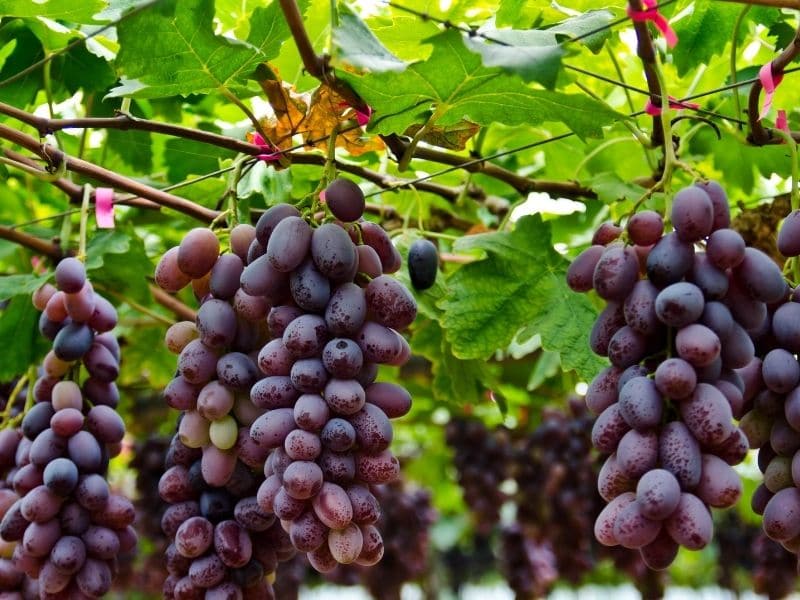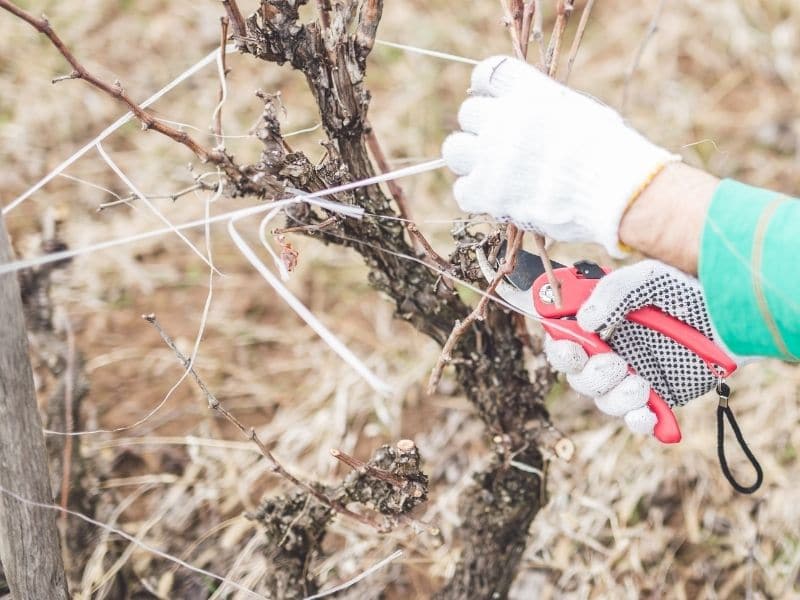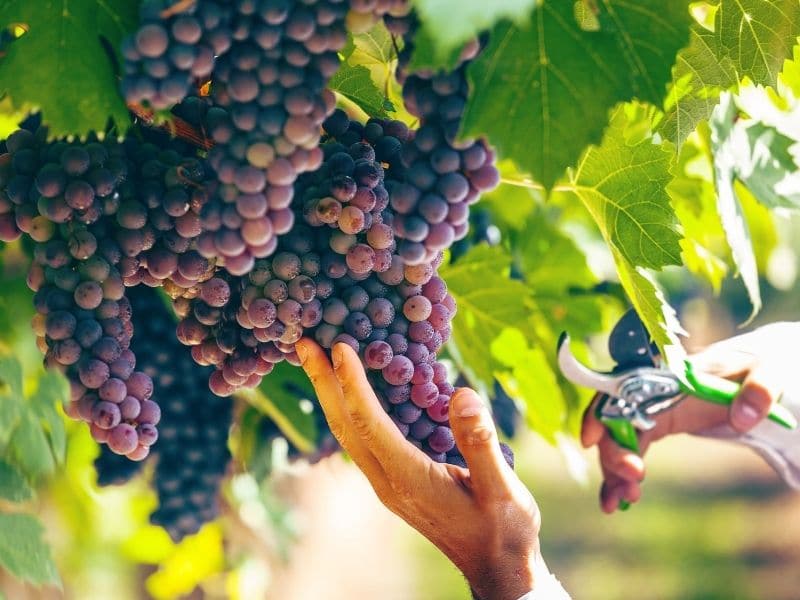Taking care of grapevines requires a certain level of expertise. Once you master your techniques, you can grow grapes in your garden. One of these techniques is pruning, a process people often do and can be hard to understand.

Pruning grapevines serves many purposes, including adjusting the vine size and shape, controlling the number of canes and nodes, and helping improve the quality of the grapes.
Everybody wants to harvest good quality grapes. It requires patience and technique. Let’s look at more information about pruning, how this practice started, the types of pruning, and the considerations you must have when doing it.
Understanding Pruning In Grapes
Pruning might seem like a whole new science. You should follow specific steps to prune your grapevine successfully. Let’s review more information about how pruning started.
History Of Pruning
There is a tale around the origin of pruning. Some people claim a donkey ate parts of a grapevine in Palestine. Humans later discovered that these grapevine clusters ended up being bigger and better than others.
Types Of Pruning
There are two common types of pruning depending on your goals.
- Spur Pruning
Spur pruning requires you to choose two canes to grow horizontally in opposite directions. It is an excellent technique for beginners. Some advantages of this process are that air and light can circulate better through the grapevine. For this technique, you need to install a trellis so that your grapevine can rely on it.
- Cane Pruning
It is one of the most common pruning techniques. Here all the canes grow vertically. It doesn’t allow light and air circulation as much as spur pruning does. However, as long as you take appropriate care of the soil and ensure proper watering, you shouldn’t have any low-quality clusters.

What You Need To Prune Your Grapevines
To prune a grapevine, you will need a pair of sharp-edged pruning shears. When pruning, you cut and remove parts of the plant because that won’t be of any use.
Bigger pruning clippers can help you to remove more difficult ones. Also, gloves can help you to protect your nails and fingers.
- Drop forged body and handles, quality blade made of high carbon steel with...
- Ideal for deadheading, trimming, shaping on tree, roses, annuals, vegetable,...
- Ergonomically designed non-slip handles are strong,lightweight,and comfortable.
Last update on 2025-07-05 / Affiliate links / Images from Amazon Product Advertising API
Things To Consider When Pruning Grapevines
Here, we made a list of a few things you should consider when pruning:
- Remove shoots that are older than a year. You will cut right above the second node.
- Remove the shoots or canes that are thinner than a pencil.
- Remove canes where you find powdery mildew.
- You should prune your grapevines by the end of the cold season or before temperatures start to get warmer. The exact month when it occurs usually varies from one location to another.
- It would be best if you cleaned your shears between each cut. You can use vinegar, rubbing alcohol, acetone, or any other tool cleaner.
- Each cut should be clean. You can rock up and down if the shoot is too tricky.
- Your cuts should be as close to the wood as possible.
- Make sure you prune the grapevine in sunny weather. Rain can negatively affect the healing process.
- Remove any unhealthy node. You would cut in the nearest healthy nod.
- The final number of shoots in your grapevine will depend on how old they are.
- Shoots should be 10 inches away from one another.
When Should You Prune Your Grapevines
As we mentioned, you should perform this process right after the winter season. During this time, the grapevine doesn’t have any leaves; this is what we call dormancy.
Pruning during dormancy allows your grapevine to be prepared for the new harvest. It is why you should remove any unhealthy shoots, because they may not produce high-quality grapes.
The exact month when you should prune your grapevine varies in function to the location. Here we have a list of some of the most common grape production locations and the pruning month for each one of them.
| Location | Pruning Month |
| California | January |
| Spain | January- February |
| Chile | February |

Other Processes Related To Pruning
Pruning is a step in the grapevine cycle. That’s why this process should be done annually. But since it’s part of a cycle, other steps will come after it. See below a list of other processes related to pruning:
- Trellis maintenance
Once you have pruned your grapevines, it is the perfect time to do some repairs to the trellis. You can replace any damaged wood or stretch the wires.
- Suckering
You will use your shears to remove any unhealthy buds.
- Summer prune
Here you will remove any excess leaves that can be providing too much shadow to the grapevine.
- Nouaison
It is the name of the process when the first grape clusters appear.
- Green harvesting
Here you will look for the grape clusters growing in each shoot. If you find two groups in the same cane, you will remove the one farther from the first node. You could also remove parts of a cluster that could be overcrowded.
- Veraison
During this process, the sugar and acidity levels in the grapes vary. You will notice the veraison process because the color of the clusters will slowly change.
- Harvest
Once the grapes have reached full maturity, it’s time to collect the fruits.
- Late Harvest
During this stage, the leaves take an orange-like color and start to fall off the grapevine. Some producers will keep a few grape clusters up to this point to dry out.
Frequently Asked Questions
When should grapevines be pruned?
You should prune grapevines after winter to allow the wounds to heal without getting infected.
Do you prune grape vines every year?
Yes, you do. It is essential to do this process because this will allow your vine to produce higher-quality grapes.
Can I prune grapevines in May?
Yes, you can. Pruning is a process that you can do from spring through the warmest season. Feel free to prune your grapevines in May if needed.
What are some common mistakes about pruning?
The most common mistake is to under prune. Some people are afraid of removing too many canes and nodes that they eliminate too little. If you noticed that your grapevine grew too many grape clusters, you could remove them before they mature.
Why is pruning important?
Pruning is important because it helps the grapevine through its dormancy process. You will want to remove unnecessary branches so that your plant can recover faster.
How do I make my grapes grow bigger?
Pruning is a crucial step to grow more giant grapes. You will look for clusters that grow out of the same shoots and remove the clusters towards the end of the cane. Use your pruning shears to make the cuts.

Final Thoughts About Pruning Grapevines
Pruning grapevines is more like training the plant. The process is essential to allow grape clusters space to grow. If you don’t yearly prune your grapevines, your next harvest can be full of small clusters that couldn’t develop properly.
You have to choose your pruning style. Spur pruning requires a trellis, while cane pruning can be done on a fence. If you don’t have a lot of horizontal space, it would be better for you to go with cane pruning.
Every year it’s a new opportunity for you to reshape your grapevine. There’s no such a thing as damaging your grapevine during pruning, as long as you follow the consideration points we aforementioned.
Allowing air and sunlight through a few grape clusters is much better than harvesting many underdeveloped grapes. We hope this information serves you well to take care of your Vitis.




